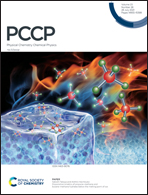The tug of war between Al3+ and Na+ for order–disorder transitions in lipid-A membranes†
Abstract
Cations play a critical role in the stability and morphology of lipid-A aggregates by neutralizing, hydrating and cross-linking these glycolipid molecules. Monophosphorylated lipid-A is the major immunostimulatory principle in commercially available adjuvants containing Al3+ such as adjuvant system 04 (AS04). The antagonist/agonist immunomodulatory properties of lipid-A are associated with chemical variations (e.g. the number of acyl chains and phosphate groups) and their aggregate arrangements (e.g. lamellar, nonlamellar or mixed). Therefore, the identification of the active form of lipid-A can provide valuable guidance in the development of vaccine adjuvants capable of boosting the immune system with decreased reactogenicity. Although the effect of mono and divalent cations on the structural polymorphism and endotoxicity of LPS has been previously investigated, much less is known about the effect of trivalent cations. We have investigated the effect of NaCl and AlCl3 salt solutions on the structural dynamics and stability of mono and diphosphorylated lipid-A membranes via atomistic MD simulations. The Al3+ ion exerts two major effects on the structural dynamics of lipid-A membranes. It acts as an efficient cross-linker of mono or diphosphorylated lipid-A molecules, thus stabilizing the lamellar arrangement of these glycolipids. It also alters the lipid-A packing and membrane fluidity, inducing disorder → order structural transitions of the membrane. This effect is promptly reversed upon the addition of NaCl solution, which promotes a nearly threefold increase in the amount of water in the carbohydrate moiety of the Al3+-containing lipid-A membranes. The exchange dynamics and residence times of cation-coordinated water molecules in these membranes provide insights into the molecular mechanism for the Na+-induced transition from a densely packed ordered phase to a disordered one. Al3+ counter-ions favor ordered lamellar aggregates, which has been previously associated with the lack of endotoxic activity and cytokine-inducing action. The resulting microscopic understanding of the structure and dynamics of lipid-A aggregates in the presence of Al3+ and Na+ salts can provide valuable guidance in the development of vaccine adjuvants capable of boosting the immune system with decreased reactogenicity.

- This article is part of the themed collection: 2021 PCCP HOT Articles


 Please wait while we load your content...
Please wait while we load your content...